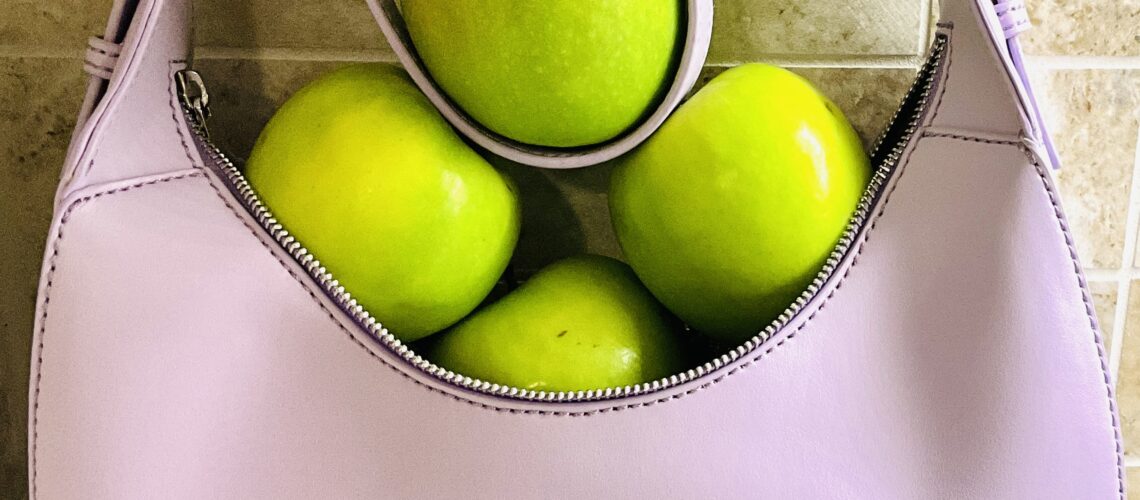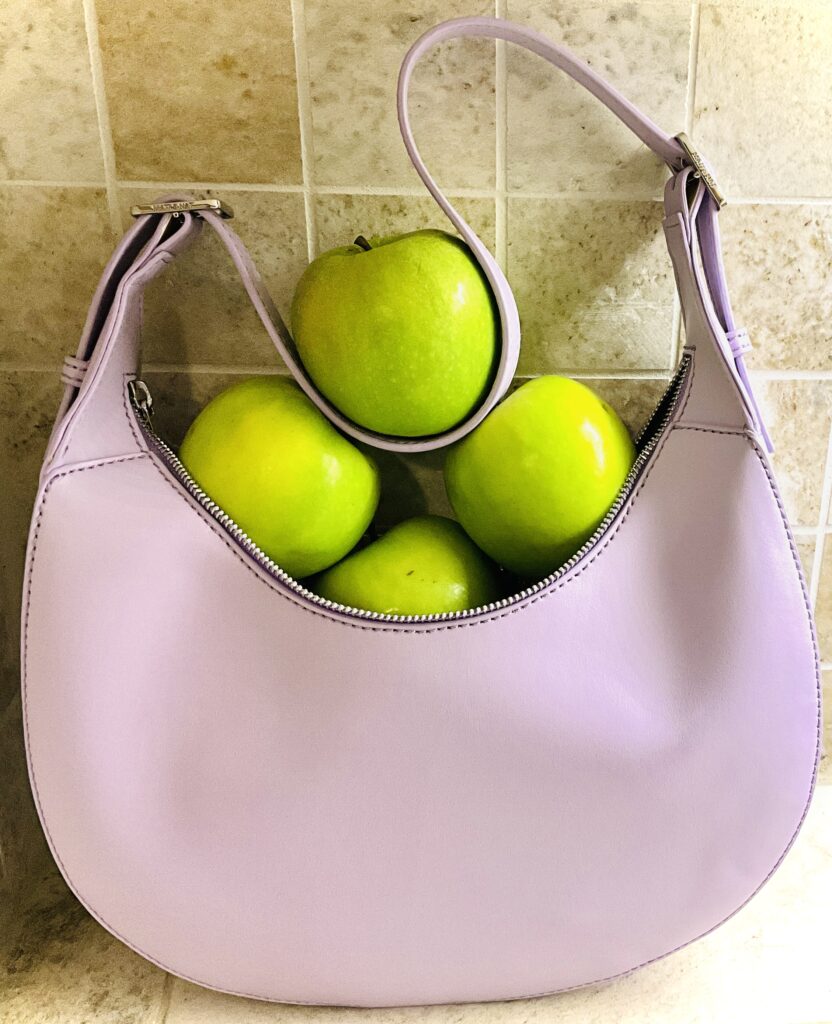In search of a non-toxic handbag

Last year when I was shopping online for a new summer purse, I kept seeing customer reviews complaining about the smell. I saw this written about multiple handbags sold on Amazon. Some reviews said the purse smelled like chemicals and some said it smelled like fish! The fish smell was definitely puzzling so I decided to look into that a bit further.
After reading a few articles online, I discovered that fishy smells are usually caused by various chemicals used in handbags made from either real or faux leather. These chemicals are present in the dye, preservatives, glue and protective coating. Another cause is the use of fish oil to treat the bags which degrades over time and begins to smell. One article suggested this problem is relegated to cheap leather goods while another said it can also be found in high-end products.
As someone who is both sensitive to smells and cautious about chemicals, I set out to find a less toxic alternative. Not only did I find two handbags with no foul odours, I discovered a fascinating new type of vegan leather.
Please note that I have not received remuneration from any of the brands mentioned in this post.
My search first led me to a new vegan textile called Apple Skin. It was developed by an Italian company called Frumat with the goal of upcycling apple waste from northern Italy’s apple juice and jam industry. Apple Skin contains up to 50% apple waste which would otherwise be discarded. The waste is dried, ground into a fine powder and mixed with polyurethane which coats the powder and holds it together. Although the material still has plastic in the mix, the amount needed is considerably reduced with the addition of the apple waste. Apple Skin is manufactured by Mabel and in 2019 the product started being used to make handbags.
Some brands that use Apple Skin include:
I looked at the Canadian brand that was closest to me: Matt & Nat’s vegan handbags. Matt & Nat stands for “material and nature.” Since its inception in 1995, this Montreal company has been committed to making eco-friendly handbags with recycled materials. Their Studio 901 collection is made with Apple Skin by Frumat and Mabel.(
Like most of the companies using Apple Skin, Matt & Nat make high-end products and their Studio 901 line is pricier than their other offerings. At first it didn’t seem like I would be able to afford one of these nifty apple handbags. However, I noticed that Matt & Nat’s end-of-season colours were on sale at half price, so I was able to get a crescent-shaped Apple Skin bag for less money. It’s a summery shade of lavender which is one of my favourite colours. I bought the bag directly from Matt & Nat in Montreal and it arrived fairly quickly. There was absolutely no smell of any kind from the bag. The material resembles leather but is a bit stiffer. I’ve had it a year and am still happy with it.

Matt & Nat makes other vegan bags that are less expensive than their Studio 901 Collection. Although they don’t contain upcycled apple waste, they do contain other recycled materials. Just like their Apple Skin (now called UPPEAL) bags, you can find the previous season’s colours and their discontinued styles at a good discount. Timing can be helpful if you’re looking for a sale item. I bought my bag in mid-August. Summer had not yet ended but their new Fall colours were already out.
Since purchasing my new purse, I discovered other brands of vegan leather-like textiles made with a variety of plant-based material.
Desserto®️is a Mexican company that makes vegan “leather” from agave waste. They also make similar products from cacti for both the fashion and automative industries. The cacti are grown using organic and circular farming systems.
Piñatex®️is made by Ananas Anam and uses pineapple leaves left over from the pineapple industry. Interestingly, they are able to make a leather-like material that contains quite a lot of pineapple leaves – up to 80%! Ananas Anam is a UK company with subsidiaries in both Spain and the Philippines.
Phool, a company based in India, makes use of discarded flowers from Hindu temples. They started out making incense from the flowers and later created a vegan textile with a texture very similar to animal leather. The process involves feeding the flowers to a certain strain of fungi which is then made into a textile they named “Fleather”.
Mycotech is an Indonesian company whose mushroom-based textile is being used to make shoes. Amazingly, this leather alternative is made without any polyurethane or other chemicals added. Although the product is currently manufactured on a small scale, this growing company has orders that will take them into 2027.
Mylo™️ is another brand of fungi-based “leather” made by Bolt Threads. They also make a silk-like product called Microsilk™️. Fashion designer Stella McCartney (yes, the daughter of Paul) has used both these materials in her vegan clothing line as well as other plant-based alternatives to leather.
VEGETEX®️ makes leather-like products using upcycled apple, lemon and barley wastes from various beverage industries. The barley waste comes specifically from Budweiser.
Fruitleather, a Dutch company started by two classmates, uses unsellable mangoes to make vegan “leather”. It can be used to make shoes, fashion accessories and products for the interior and furnishing industry.
If Fruitleather becomes known as a non-edible textile that you can wear, we may have to call the edible fruit leather by a different name! Maybe we can call it fruit jerky!
I find this new way of making faux leather absolutely fascinating and can’t wait to see how the industry evolves. That said, there are companies making genuine leather handbags that are also looking to be more eco-friendly. The Sak is one such company and when my winter purse was worn out and in need of replacing, I purchased one on Amazon Canada. I was able to get it on sale and when it arrived there was no foul odour whatsoever.
The Sak makes handcrafted bags using leather, suede and recycled plastic. They source 100% of their leather from tanneries that comply with environmental and water usage guidelines set by the Leather Working Group (a non-profit leather sustainability organization). Recycled plastic is used in their vegan certified crochet bags and in all their purse linings. It’s also used in their Sakroots line of bags made from a canvas-type material called Eco Twill.
I am planning to take good care of my winter purse so it lasts a long time. The Sak recommends using a water-based weather protection spray on their genuine leather bags. This sent me on yet another search for something less toxic than typical products. I settled on a brand called Nikwax which is made with ingredients safe enough to be used indoors. It is water-based, and contains no PFCs, VOCs, optical brighteners or added scent. I bought the one with the sponge applicator to reduce the amount of product getting into the air. Sadly, they will be discontinuing that type of applicator as most people prefer the spray. Nikwax worked great. I was briefly caught in the rain one day and my bag was no worse for wear! Note that Nikwax is not recommended for use on faux leather.
I’m glad I was able to find eco-friendly bags that are well-made and have no foul odour. I’m looking forward to seeing more new products come on the market made with plant waste materials. I think vegans will positively LOVE this new development. The environmental benefits will be great for everyone! 🍏
References and Recommended Reading
In addition to the links and videos throughout my blog post, the articles below provide further information.
What Is Apple Leather? (And 10 Fashion Brands Using It) (Sustainably Chic, May 10, 2023)
The vegan leather made from India’s waste flowers (By Sushmita Pathak, BBC, December 19, 2022)
From mangoes to leather: Fruitleather, the idea of two classmates (Lampoon Magazine, August 19, 2021)
Frumat, the Leather Alternative Made from Apples (Technofashion World, March 22, 2019)
Apple Leather – A Unique Story for a Unique Fabric (Oliver Company London)
Explaining Unpleasant Odours That Can Come From Cheap Leather Bags & Goods (By Camilla Shep, Mahi Leather)
7 Reasons Faux Leather Bag Smell Like Fish: Plus 6 Easy Fix (Leather Informer)
6 Common Problems With Faux Leather Fishy Smell (Plus Fix) (By Samantha Gilbert, Leather Knowledge)
No Comments